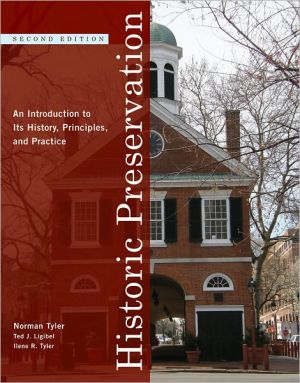Historic Preservation: An Introduction to Its History, Principles, and Practice
Historic preservation, which started as a grassroots movement, now represents the cutting edge in a cultural revolution focused on “green” architecture and sustainability.\ This is the only book to cover the gamut of preservation issues in layman’s language: the philosophy and history of the movement, the role of government, the documentation and designation of historic properties, sensitive architectural designs and planning, preservation technology, and heritage tourism, plus a survey of...
Search in google:
Historic preservation, which started as a grassroots movement, now represents the cutting edge in a cultural revolution focused on “green” architecture and sustainability.BooknewsIn non-technical language, architect Tyler (historic preservation, Eastern Michigan U.) explains the philosophy and history of the movement, the role of government, the documentation and designation of historic properties, establishing a historical district, sensitive architectural design and planning, technology, and economics. He illustrates many of the terms in the glossary, but does not indicate how to pronounce them. The 1994 edition was titled . Annotation c. Book News, Inc., Portland, OR (booknews.com)
Preface91Introduction112The Preservation Movement In the United States333Historic Districts and Ordinances594The Legal Basis for Preservation835The Documentation and Designation of Individual Historic Properties936Architectural Styles1087Design Issues1398Preservation Technology1549Downtown Revitalization16810Preservation Economics18411Other Preservation Issues208Notes220Further Reading228App. 1Preservation Resources232App. 2Degree Programs in Historic Preservation240Architectural Terms242Index247
\ Old Mill News[T]he classic textbook for the field.\ \ \ \ \ Civil EngineeringHistoric Preservation is a book that, in being named after its subject, invites high expectations and meets them all.\ \ \ The Midwest Book ReviewLibraries strong in architecture and historic preservation will find the second updated edition of Historic Preservation a winner.\ \ \ \ \ The New England Antiques Journal[A] thorough introduction to the sometimes complicated subject of historic preservation….clear and concise…Current with today’s issues.\ \ \ \ \ Preservation Education & Research[I]ndispensable….the authors and the book’s editorial advisors accomplish what no others have to date. This is the intellectually accessible basic textbook—that Preservation 101 we all have been seeking. It is useful as a basic reader in the undergraduate classroom, serves as a quick reference for graduate students…and provides information for professionals in foreign countries on how preservation is practiced in the United States. It can also be dipped into as needed by preservation volunteers who, after all, form the backbone of American preservation on a community level.\ \ \ \ \ Alabama Trust for Historic Preservation“[D]eserves a place in the home of anyone interested in the activities of preservation….If we could have only one book on the practice of historic preservation, this may well be that book.”\ \ \ \ \ Colonial Latin American Historical ReviewThis book is recommended to students, planners, and citizens interested in the preservation and protection of our local, regional, and national patrimony.\ \ \ \ \ Paul Hardin Kapp - Bulletin of the Illinois Geographical Society“…an impressive textbook…As someone who teaches historic preservation theory to architects, I am looking forward to using Historic Preservation as one of my textbooks next year. I will also recommend this book to anyone interested in historic preservation. Local government officials, historic district commissioners and even owners of historic buildings can all benefit from reading this book.”\ \ \ \ \ Bulletin of the Illinois Geographical Society…an impressive textbook…As someone who teaches historic preservation theory to architects, I am looking forward to using Historic Preservation as one of my textbooks next year. I will also recommend this book to anyone interested in historic preservation. Local government officials, historic district commissioners and even owners of historic buildings can all benefit from reading this book.\ \ \ \ \ The Midwest Book Review“Libraries strong in architecture and historic preservation will find the second updated edition of Historic Preservation a winner.”\ \ \ \ \ Civil Engineering“Historic Preservation is a book that, in being named after its subject, invites high expectations and meets them all.”\ \ \ \ \ Colonial Latin American Historical Review“This book is recommended to students, planners, and citizens interested in the preservation and protection of our local, regional, and national patrimony.”\ \ \ \ \ Old Mill News“[T]he classic textbook for the field.”\ \ \ \ \ The New England Antiques Journal“[A] thorough introduction to the sometimes complicated subject of historic preservation….clear and concise…Current with today’s issues.”\ \ \ \ \ Preservation Education & Research“[I]ndispensable….the authors and the book’s editorial advisors accomplish what no others have to date. This is the intellectually accessible basic textbook—that Preservation 101 we all have been seeking. It is useful as a basic reader in the undergraduate classroom, serves as a quick reference for graduate students…and provides information for professionals in foreign countries on how preservation is practiced in the United States. It can also be dipped into as needed by preservation volunteers who, after all, form the backbone of American preservation on a community level.”\ \ \ \ \ BooknewsIn non-technical language, architect Tyler (historic preservation, Eastern Michigan U.) explains the philosophy and history of the movement, the role of government, the documentation and designation of historic properties, establishing a historical district, sensitive architectural design and planning, technology, and economics. He illustrates many of the terms in the glossary, but does not indicate how to pronounce them. The 1994 edition was titled . Annotation c. Book News, Inc., Portland, OR (booknews.com)\ \








